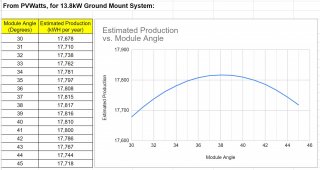Turkey Hollow Solar
New Member
We're installing a 13.8kW (DC) ground mount system with Bifacial panels here in Northern VT. This is for a net-metering system only at this time, so the objective is to maximize annual production.
The ground mount is the Nuance Osprey system, which allows for setting any desired tilt angle.
I did some quick analysis of various tilt angles using PVWatts. Here is a table of the estimated production vs. module tilt. It shows that 38deg is the optimal angle for our location.

A few observations on this data:
- tilt angle doesn't seem to matter that much, at least in the range shown here, which is 30deg to 45deg. The difference between the lowest (30deg) and highest (38deg) is only 139kWH, or about 0.8%.
- it predicts that 38deg is the optimal angle
- PVWatts doesn't yet have an option for bifacial panels, so I'm just using the "premium" option
If this was a rooftop, this would equate to the range between a 7/12 and 12/12 pitch. I'm surprised that there wouldn't be more response to tilt angle.
For people with experience in New England, does a 38deg tilt sound good to you? Does this low response to tilt surprise you?
We were originally planning to use 35deg, which is conventional practice around here. However, a little more tilt to 38deg seems like it would help snow shedding, and could help the bifacial panels pick up more ambient light from the back side.
We also considered that maybe a little lower tilt could be better to pickup more production in the summer months when the days are longer. But this data suggests that thinking isn't valid...at least based on the PVWatts models.
I'm interested in your thoughts!
The ground mount is the Nuance Osprey system, which allows for setting any desired tilt angle.
I did some quick analysis of various tilt angles using PVWatts. Here is a table of the estimated production vs. module tilt. It shows that 38deg is the optimal angle for our location.

A few observations on this data:
- tilt angle doesn't seem to matter that much, at least in the range shown here, which is 30deg to 45deg. The difference between the lowest (30deg) and highest (38deg) is only 139kWH, or about 0.8%.
- it predicts that 38deg is the optimal angle
- PVWatts doesn't yet have an option for bifacial panels, so I'm just using the "premium" option
If this was a rooftop, this would equate to the range between a 7/12 and 12/12 pitch. I'm surprised that there wouldn't be more response to tilt angle.
For people with experience in New England, does a 38deg tilt sound good to you? Does this low response to tilt surprise you?
We were originally planning to use 35deg, which is conventional practice around here. However, a little more tilt to 38deg seems like it would help snow shedding, and could help the bifacial panels pick up more ambient light from the back side.
We also considered that maybe a little lower tilt could be better to pickup more production in the summer months when the days are longer. But this data suggests that thinking isn't valid...at least based on the PVWatts models.
I'm interested in your thoughts!


